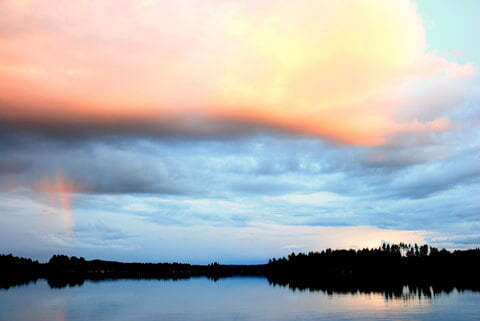The largest lake district in Europe and Lake Saimaa
Known as the land of a thousand lakes, Finland presents itself with numerous lakes that inspire people with different sizes and scenic facets. Everywhere in the country you come across lakes, which could hardly be more impressive and which are characterized by a pristine nature.

A highlight of a special kind is the Finnish Lake District. With it presents the largest lake district in Europe. It is home to an unprecedented jumble of lakes, forested islands, bays and small peninsulas. Few landscapes are more characteristic of Finland than the Lake District. Here are the synonyms associated with the northern European country. The numerous lakes are connected by canals or natural drains, which always offer impressive rapids, waterfalls and cascades.
The Finnish Lake District resembles a labyrinth composed of forests, water, hills and land. Many visitors lose track in these realms and no longer know where a single lake ends or begins. Almost one third of the country is covered by the Finnish Lake District. Essentially, the impressive area consists of three large water basins. They are loosely connected and leave a scenic picture that could hardly be more beautiful. While Näsijärvi presents itself in the west near Tampere, the middle of the lake district is dominated by the elongated Päijänne. In the east, the huge Lake Saima shapes the image of the Finnish Lake District. In Vuoksen, Lake Saimaa has an outflow to the southeast. All three lake systems lie around 76 to 78 m above sea level and are framed by a nature that could hardly be more beautiful and pristine.
Lake Saima in the southeast is the largest of all Finnish lakes and is considered the center of the Finnish Lake District. Historically, the region was characterized by active rafting. Imposing logs were carried across the lake in huge rafts. In the meantime, this traditional route has also lost importance in Finland and now accounts for only around 20 percent of all transports. The impressive Saimaa lake system was formed after the last ice age. It was cut off from the nearby Baltic Sea by a land uplift. Along the way, the Arctic ringed seal, which once lived in the Baltic Sea, was separated from the sea. It evolved over centuries into a subspecies now known as the Saimaa ringed seal. Today, this seal species is still found in the Saima Lake area. However, it is considered endangered and thus enjoys special protection. To the north, the Finnish Lake District is bordered by the Suomenselkä mountain range on the border with Savo Province. It forms the well-known watershed that stretches between the Gulf of Bothnia and the Gulf of Finland.
Lake Saimaa – the watery heart of Finland
Due to its impressive size, Lake Saimaa is now often referred to as the watery heart of Finland. In recent years, it has been given the nickname “Lake of a Thousand Islands”. Today, it is rightly one of the most famous lakes in the country and is considered a paradise for nature lovers and activity enthusiasts. Lake Saimaa forms the southernmost part of the largest European lake system and is connected to the Finnish Lake District by numerous sounds and streams. From the air, the area of Lake Saimaa resembles an impressive labyrinth.
However, for many years Lake Saimaa has been known not only for its beautiful shore areas, but has also been able to make a name for itself thanks to its own abundance of fish. Lake Saimaa is just 76 meters above sea level. In some areas it reaches a depth of up to 90 meters. Without its numerous islands, the size of the lake is an impressive 1300 km². In addition, the Finnish Lake District covers an area of nearly 7000 km².
The terminal moraine wall of Salpausselkä forms the low edge of the lake. As a ridge of high ground, it prevents Lake Saimaa from draining directly to the south. Visually, the lake system appears deeply dark. Only in very shallow places the water is characterized by a yellow shimmer. The lake system has its origin in the numerous bogs of Finland and is thus characterized by extraordinary water colors. The Vuoski drains the entire lake system and leaves the Saimaa north of the city of Imatra. After a stretch of about 150 km, it finally flows into Lake Ladoga, which is located in Russian territory. The shore of Lake Saimaa is characterized by a shallow hilly landscape and numerous coniferous forests. In the northern climes, there are always small birch forests covering the hills.
The fresh water of Lake Saimaa
In many ways, Lake Saimaa resembles an extraordinary paradise that could hardly be more exciting. It is above all the fresh water that characterizes the region. Due to the fresh water, the region became home to a rich fauna, characterized by countless rare animals. This includes the Saimaa salmon. But the Saimaa ringed seal is also one of the favorites of the numerous animal lovers who visit the lake every year. The seal species is found mainly in the northern part of the lake. In this area live about 220 to 250 animals of this endangered seal species. With calmness and patience you can still get to see this extraordinary seal species.
The best way to discover the flora and fauna of the Saimaa Lake District is by hiking. Hikes are recommended, especially in the Linnansaari National Park. The main part of the impressive protected area extends about 45 km northwest of Savonlinna in the Rantasalmi region. Linnansaari National Park is characterized by the impressive Lake Haukivesi.
Rambling through Linnansaari National Park
Haukivesi is one of a total of three large inland lake nature reserves in Finland. The impressive area extends over a length of 40 kilometers. In the area there are 130 islands, which have a size of at least one hectare. A large number of smaller archipelagos form an impressive area of 36 km². Linnansaari National Park is best reached from Savonlinna. Road 14 leads from the famous Finnish town to Parkumäki. On the road 464 the road continues to Rantalsami. To date, the nature park can be reached only by boat.
During the high season, boats run regularly from Rantasaari and Oravi. The main island of the nature reserve is home to several hiking trails that can be used. Besides, there is an interesting nature trail for the guests, which leads through the most beautiful traits of flora and fauna. There is a well-equipped campsite in Sammakkoniemi from May to September. It is home to several cabins that can be used for overnight stays. There are another 15 campsites in the area, which invite you to spend the night outdoors, especially during the summer. In Rantalsalmi is the visitor center Lakeland. It holds a lot of information about Lake Saimaa and the lake district. A special offer awaits the guests of the region in Lappeenranta. During the summer, several operators in the city offer small cruises on the Saimaa, which show the lake from a very special side.
The Saimaa Canal – a special landmark
Among the landmarks of the famous Lake Saimaa is the Saimaa Canal, which has become a popular destination for tourists. In 1850, the canal was built as a masterpiece of engineering. It extends over a length of 42.9 km and was completed with 19.6 km on the Russian side. It connects Lake Saimaa with the Gulf of Finland. In total, the Saimaa Canal covers a height difference of 76 meters, which is reached and overcome by 8 locks.
For a long time, the Saimaa Canal was reserved for a few ships. Only in 1991 it was opened for boating tourists and today it is considered a popular destination for a trip on the water. Lake Saimaa was connected with other large lakes of the Finnish Lake District through other channels. Thus, the Taipale Canal near Varkaus and the Konnus Canal near Leppävirta created important connecting routes that shaped Finnish rafting in history. Today, the canals are used exclusively by industrial and tourist inland navigation.
The small town of Lappeenranta
One of the most famous destinations on Lake Saimaa is the Finnish city of Lappeenranta, home to around 59,000 people. It is located in the southeast of the country and is the southernmost starting point for shipping on Lake Saimaa. Historically, the city benefited from its exposed location on the border with Russia. Due to its location, it received a garrison as early as the 17th century. The city is still considered the gateway to the East and is visited by numerous tourists every year. Due to its location on Lake Saimaa, the area has become a popular vacation destination.
Lappeenranta once emerged from a medieval trading center. In 1741 it became the scene of a decisive battle in which the Russians defeated a Swedish-Finnish army. In 1743, the city fell to Russia in the Peace of Turku. Even today in Lappeenranta you can still find ramparts of the former city fortifications, which in the 17. and 18th century were created. In 1824, a radioactive mineral spring was discovered in the town. With its discovery, a lively spa business was established in the town, attracting mainly noblemen from Russia. Lappeenranta is rich in sights that find their roots in past centuries and provide a jump into history.
One of the most beautiful destinations is the South Karelian Museum, which was placed in the northern part of the fortress. It presents impressive Karelian costumes to its guests. Besides, it is home to exhibits originating from the former Finnish town of Vyborg. At the same time, the model of the city is extremely interesting. The Lappeenranta Fortress Guard is now home to a cavalry museum, which presents various saddles and weapons of the Finnish cavalry in addition to numerous uniforms. Besides, the area of the old fortress is home to an interesting art museum.

